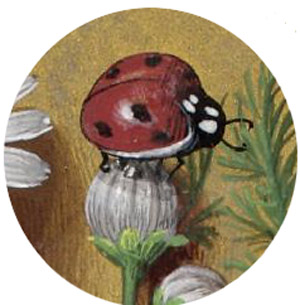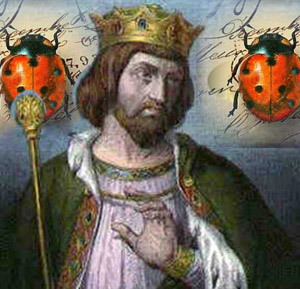Symbolism
 |
 |
 |
 |
 |
 |
 |
Our Lady’s Bug: A Symbol of Protection

The lady beetle's 7 spots signify Our Lady's 7 Joys and Sorrows

Somewhere in very early medieval Europe, swarms of destructive insects invaded the land of a region and began to destroy the crops. Fearing their needed foodstuff would be ravished and their families would not have enough to eat for the winter, the people had recourse to Our Lady, petitioning her to save them from that plague.
Shortly, a huge cloud of small, black-spotted, orange-red insects descended from the heavens onto the crops of the farmers, devouring the pests. Thus the crops were saved. The grateful population gave the name “Our Lady’s Beetles” to this amiable and helpful red insect, which came to symbolize protection.
Its official name coccinellids is derived from the Latin word coccineus meaning scarlet, describing its bright red shell. In many medieval paintings Our Lady was depicted wearing a red cloak, and the spots of the seven-spot ladybird, the most common of the almost 5,000 species, are said to symbolize her Seven Joys and Seven Sorrows. In England, the insects are known as "Our Lady's birds" or the “Lady beetles.” In our country, the name was shortened to "ladybug."
By the way, many of the names in other European languages also refer to Our Lady: The German name Marienkäfer translates to Mary beetle; in Croatian they are called Bubamara, Mary's beetle; in Bohemian it is Frauenkäferlein, Our Lady's little beetle.
The Ladybug, truly a protection for crops
What is not legend but solid fact is that our eye-catching ladybugs are devourers of aphids – each one will eat up to 50 a day – and other crop-destroying pests. Its legendary appetite was put to a test in California in the 1880s. The California citrus growers were facing a catastrophic invasion of an Australian scale insect that was killing large groves of lemon and orange trees.
The orchard owners grouped together and purchased hundreds of thousands of Australian ladybugs and released them in their groves. Within two years, the invasion of scale insects was fully conquered and the trees were bearing fruit again. Without chemicals, the diligent ladybugs had saved the groves. The ladybug had proved her title as a symbol of protection.
Today many organic farmers order large boxes of ladybugs for their gardens and orchards; even small home gardeners are ordering smaller quantities of the beneficial insects that eat aphids, mealy bugs, scale insects, leaf hoppers and other destructive pests.
A sign of good luck
The ladybug also came to be a sign of good luck or good fortune. This symbolism also has roots in a medieval legend.

King Robert II the Pious pardoned a criminal because of a ladybug
The executioner repeatedly tried to shoo it off, but it stubbornly returned each time.
King Robert, called the Pious or the Wise – he was known for his devotions and lack of tolerance for heretics – saw the action of this little insect as a divine intervention, a sign of un bête à bon Dieu, a beast of the good God.
Thus he halted the execution. In fact, shortly after this providential intervention, the man was proved to be innocent of the crime.
Many old wives' tales about the luck the ladybug is said to bring have come down to us today.
Most of us have heard some of these superstitions: If a ladybug lands on you, be careful not to brush it off. Stay very still and count the spots. The number of spots will reveal the number of months you will enjoy good luck. The stronger the color red is on the ladybug, the better your luck will be.
Others believe you get to make a wish if a ladybug lands on your hand. If you are holding the ladybug in your hand while making the wish, the direction that it flies when it leaves shows the direction from which your luck will come.

A sign of coming good fortune
In France, if a ladybug lands on you, whatever ailment you have is said to fly away with it. Killing one deliberately will bring sadness and misfortune.
The Belgians used to say that if a ladybug crawled across a young lady's hand, she would be married within a year. Now then, I'm not sure if that is good luck or not, but many the young lady have believed it so.
Bretons hold that the ladybugs’ arrival brings fair weather. In Italy, if a ladybug lands on an infant or cradle, the mother smiles and says it is a sign of blessings for her child. In fact, the ladybug's Italian nickname is “commaruccia” which translates into “little midwives.”
Thus has this eye-catching little ladybug come to signify protection and good fortune for peoples around the world.


Posted April 4,, 2018
Posted June 20, 2018
______________________
______________________











